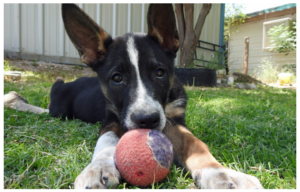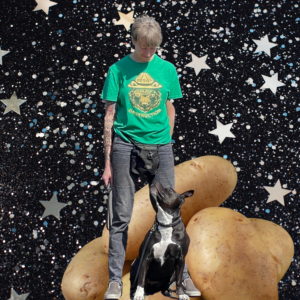Barks Blog
Stubby’s Story: From Crossroads to Heart Dog
This article is the winning entry in the BARKS 2023 Summit Writing Competition!

by Hannah Blumenfeld
Stubby was born in western Texas in February 2020. He and his four littermates ended up in a small shelter and then spent three weeks in a foster home before being transported to a rescue in Portland, Oregon, in May 2020. His fosters in Portland had a full house—two adults, two teenagers, a 4-year-old male neutered English Mastiff, and a 4-year-old female spayed cat. They adopted Stubby as soon as his litter was cleared for adoption.
In March 2021, his adopters reached out to the rescue with the following report:
We are struggling most with leash walking. I have observed his reactivity increase over the past few months in terms of frequency, intensity, and types of stimuli that seem to catch his attention. He barks and lunges at people who are outside, at people who say hello to us, at children playing, and at other dogs. I’m usually able to distract him with treats when I see another dog coming (we always cross the street or allow for a wide berth when I see someone coming toward us), but when I’m surprised, we end up in this dance where he’s jumping, twirling, barking, lunging, rearing, and then trying to bolt while I’m holding onto the leash and trying to pull him away from whatever is catching his attention.
The rescue referred them to a local R+ trainer, who recommended Engage-Disengage and a consult with their primary vet for possible psychopharmaceutical intervention. In April 2021, their vet prescribed paroxetine for Stubby.
In June 2021, his adopters reached back out to the rescue with the following update:
We are at a crossroads and need to decide how to proceed. Stubby has continued to struggle mightily with people coming over (barking, lunging, growling, pacing) and he just really cannot settle. We have had two instances of people visiting last month, and both times he had a really, really hard time with anyone new in the house. For the entire time. Putting him in another area of the house didn’t work at all, nor did he get used to anyone after some time had passed.
In July 2021, I began working with Stubby and his adopters.
At our first session on July 11, I found Stubby to be an incredibly smart, sweet, slightly worried dog. One of his littermates had gotten a DNA test—the dogs were 45% cattle dog, 20% German shepherd, 13% pit bull, and 10% Dutch shepherd. A spicy little mix! We began by establishing ground rules for all visitors to the home: no eye contact, no reaching out, and no hand-feeding. We talked about tossing treats as a way to provide Stubby with the additional reinforcement of distance. Since the adopters had reported putting him in another area of the house without success, we fine-tuned that plan to include frozen treats, white noise, and, more importantly, practice when no visitors were present. Next, we discussed the two important pieces required to address leash reactivity: management and training. Management included recognizing Stubby’s threshold, maintaining distance, and practicing an emergency u-turn, a hand target, and “find it.” Training included Engage-Disengage (only level one: engage). Finally, I stressed the importance of meal enrichment, including food scatters, cardboard “destructo” boxes, and snuffle mats.
At our second session on July 17, I coached Stubby’s adopters on Engage-Disengage.
At our third session on August 16, we took a deep dive into using management tools on walks. We discussed using Stubby’s ability to engage with his adopters as an indicator of his arousal level. We worked on a hard target and “find it” for redirection and talked about when to use each—for example, a “find it” treat scatter is helpful when the adopters need to check around corners for potential triggers, and a hand target is helpful when they need him to move quickly at their side. We taught Stubby “paws up!” on objects in the environment as a fun way to keep him active and engaged on walks. We worked on an emergency u-turn using a silly running cue.
On August 29, I received this update from the adopters:
Stubby is amazing! Your training has helped us grow even closer, and now we both actually enjoy our walks. I feel much more confident in my ability to manage situations where Stubby may feel nervous, and it really does seem like we are working together and having fun. Stubby is much more relaxed. Overall, he has experienced fewer triggers, and his need for recovery time is decreasing.
At our fourth session on November 12, the adopter’s father and stepmother were present. They have historically struggled with Stubby’s reaction to their visits. I asked them about their own dog experience, and they said they have always had labs. To help contextualize Stubby’s behavior during their visits, I talked about his herding breed mix and explained that he is pretty hardwired to care deeply about people moving around in the environment. I compared that to the typical breed characteristics of labs and other hunting dogs. We actually practiced an entire visit from the beginning! I arrived first and the adopter put all the dogs away with special treats and noise. They had been practicing this since July and it has been very effective. When the parents arrived, we were able to talk about Stubby without the additional stress of managing the dogs. The adopter first brought out their other dog, Lassie, who was happy to see the guests and eat treats. I instructed the parents to follow the original ground rules for interacting with Stubby. When Stubby came out, they avoided eye contact and tossed treats away from them. I instructed the adopter to remind Stubby that he can interact with her instead! These were my follow-up notes:
I really like putting the dogs away for arrivals and then letting Lassie out first. Everyone did a great job at their specific roles—you as safe haven (come back to me, Stubby!), guests as safe strangers (tossing treats away and otherwise ignoring), and dogs as toddlers (155-lb Lassie: ‘I’m not in the way, no I’m not, what do you mean I’m in the way?’ Stubby: ‘Woof’). Stubby had incredibly clear body language showing his preference for proximity to YOU. You just need to remind him of that option! Fearful dogs often get stuck too close and they literally forget that they can move away. Having guests toss treats away as soon as he begins to approach is an excellent way to help him remember. You calling him away when he looks like he’s getting stuck is also perfect. You can always put them away again when people (or you!) need a break!
In later sessions, I introduced the adopters to Leslie McDevitt’s pattern games, specifically Up-Down and 1-2-3. And in March 2022, the adopter emailed me this: “Stubby is my whole heart.” I am so proud of Stubby’s adopters for reaching out for help and of Stubby for being such a resilient pupper. My work as a behavior consultant can be really emotionally difficult, and sometimes there are bad outcomes. Stubby’s case is a wonderful reminder that there are good outcomes, too—outcomes that actually improve the well-being of both dog and human, and that strengthen their relationship to such a beautiful degree. Thoughtful training plans and some anxiolytics (huge shout-out to Dr. Alayson Phelps at Brooklyn Yard Veterinary Hospital for her passion and expertise) can make all the difference between a struggling adoption and a heart-and-soul connection.
* * *


